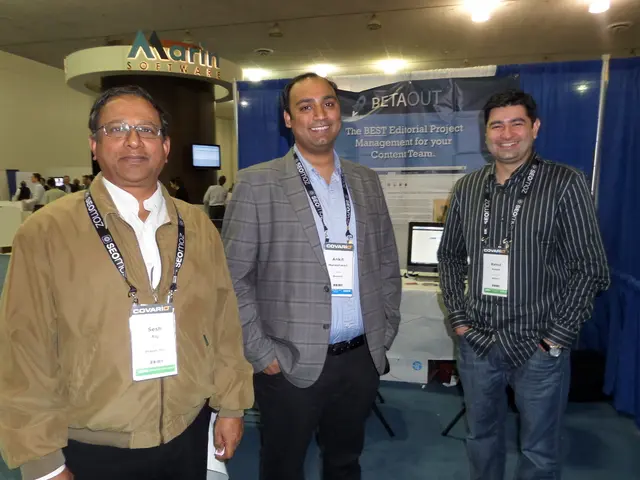Racing for Adoption: Ultra-Fast Blockchains Set to Secure Market Dominance (Opinion)
Blockchain can't just keep up with speed - it needs to annihilate the antiquated experiences of Web2. If blockchain can't offer a seamless user experience, it'll be buried under the rubble of irrelevance, no matter how revolutionary or decentralized it is.
Adamant evidence supports this claim: according to a16z's Builder Energy Dashboard, about one-fifth of crypto builders spend their effort on infrastructure development, with Layer 1 and Layer 2 projects accounting for more than a third of that segment. Most of these projects focus on delivering high-speed transactions at a reasonable cost, reflecting a colossal hurdle in the industry - scalability and processing times.
But let's not myopically focus on the number of transactions per second. Achieving lightning-fast transactions isn't an ultimate goal; it's a means to an end - creating a better user experience. In the areas where Web3 is making ripples - trading and gaming - rapid settlement is no longer a luxury, but a necessity to compete with the established titans of Web2.
Trading's On-chain Onslaught
Crypto trading is in a frenzy, and demand for on-chain platforms is exploding. According to a16z's annual State of Crypto report, decentralized exchanges (DEXs) now take care of 10% of total spot crypto trading, a seismic shift from just four years ago when centralized exchanges (CEXs) monopolized the market.
Meanwhile, the total value locked (TVL) in DeFi has surged past $100 billion for the first time since 2021 and continues to expand, with analysts forecasting a 45% Compound Annual Growth Rate (CAGR) through 2032. The market is increasingly appreciating the benefits of transparent, peer-to-peer trading over the opaque systems of centralized platforms.
Yet, we're not operating in a bubble; TradFi isn't a dormant entity. If on-chain trading platforms want to siphon users away from TradFi, they must offer speed, a smooth user interface, and reliability comparable to platforms like Robinhood or Fidelity. It's futile to compete with TradFi's centralized servers in raw speed, but that's not where Web3 excels. Its advantage isn't measured in milliseconds – it's measured in trustlessness, finality, and programmable finance - things that TradFi can't match.
The battle isn't merely about execution speed, but about how much trust, efficiency, and adaptability Web3 can bring to the financial stack. On-chain trading isn't about supplanting TradFi – it's about developing a financial system where finality is instant, markets are open, and speed serves trust, not intermediaries.
Web3 Game Studios' Self-made Chains
Gaming has caught fleeting attention, from Axie Infinity's early surge to NBA Top Shot's collectibles boom. However, sustainable adoption remains elusive. In 2025, Ton has emerged as a hub for blockchain gaming with hits like Hamster Kombat, Notion, and Catizen. These trends signify that blockchain can add intricate layers of ownership and economic incentives to gaming, but viral success doesn't ensue longevity.
The opportunity lies in instant asset settlement, true player ownership, and unshackled economies, but only if blockchain technology can churn out transactions at speeds identical to traditional game servers. If transaction delays or high fees cause friction, Web3 gaming risks being a parlor trick instead of a paradigm shift - a quirky diversion rather than a transformative force in the industry.
In contrast to DeFi and trading platforms, blockchain gaming is still in its experimental stage. Developers face a different set of challenges: while traders might tolerate some transaction costs, gamers will not. If fees and latency mar gameplay, blockchain titles won't compete with the sleek experience of traditional games, compelled to build their own chains for uninterrupted performance, like Sky Mavis with Ronin or Dapper Labs with Flow.
This signals a pressing need: Web3 gaming demands infrastructure tailored for high-speed, low-cost transactions at a massive scale. Instead of making developers spend their time solving these problems, the industry must furnish blockchains that are potent, yet invisible. After all, game creators should focus on what they do best - crafting engaging experiences, not reinventing the wheel.
The Quest for High-speed Blockchains
If blockchain is ever to satisfy high-demand use cases like on-chain trading and gaming, the industry needs scalable, high-speed networks that shatter Web2's flawless experience. Although Solana's rapid rise indicates the appetite for swift, affordable block space, Solana struggles with uptime, hinting at the challenge of delivering scalable speed without compromise. Ethereum's Layer 2 solutions, while enhancing speed and cost efficiency, deal with interoperability and fragmentation headaches.
The tide is turning, but the clock is ticking. Blockchain infrastructure must evolve fast enough to realize Web3's lofty dreams before Web2 disruptors colonize its brilliant ideas. Speed is crucial, but speed alone isn't enough. The real goal isn't merely to mirror Web2's performance - it is to establish a trustless, open, and modular foundation that Web2 can't recreate.
Author Bio
Tristan Dickinson is the Chief Marketing Officer at exSat Network, a docking layer for Bitcoin. With expertise from the banking, financial services, Web3, and technology sectors, Tristan is a visionary and dynamic marketing executive.
Binance Free $600 (our website Exclusive): Use this link to register a new account and receive $600 exclusive welcome offer on Binancefull detailsLIMITED OFFER for our website readers at Bybit: Use this link to register and open a $500 FREE position on any coin!Web 3 Facebook Twitter LinkedIn Telegram
- Tristan Dickinson, the Chief Marketing Officer at exSat Network, emphasizes the need for blockchains to surpass the seamless experience of Web2 to remain relevant.
- In the areas of trading and gaming, rapid settlement has become a necessity to compete with Web2 titans. On-chain trading platforms must offer speed, smooth user interface, and reliability comparable to platforms like Robinhood or Fidelity.
- The total value locked in DeFi has surged past $100 billion, and the market is increasingly appreciating the benefits of transparent, peer-to-peer trading over opaque systems of centralized platforms.
- In blockchain gaming, viral success doesn't ensure longevity. The opportunity lies in instant asset settlement, true player ownership, and unshackled economies, but only if blockchain technology can deliver transactions at speeds identical to traditional game servers.
- Developers face challenges in blockchain gaming, and the industry must furnish blockchains that are potent, yet invisible, to allow game creators to focus on crafting engaging experiences, not on reinventing the wheel.







